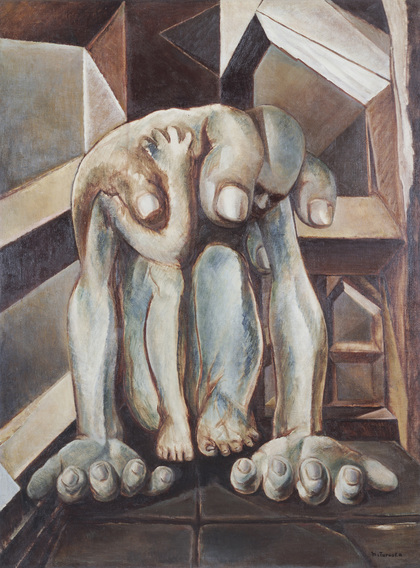-
From Current Issue
-
- Editor’s Letter Fire in the Heart
- Reviews I Gusti Ayu Kadek Murniasih
- Reviews 11th Seoul Mediacity Biennale: “One Escape at a Time”
- Dispatch Networked China
- One on One Monira Al Qadiri on Yukio Mishima
- Essays The rise of independent art spaces in pandemic-era Shanghai
- Features Tuan Andrew Nguyen
- Table of Contents
- Web Exclusives
- Archive
- Subscribe

R
E
V N
E
X
T
Installation view of YASUMASA MORIMURA’s Portrait (Shonen 1, 2, 3), 1988, C-prints, transparent medium, 210 × 120 cm each, at "Weavers of Worlds – A Century of Flux in Japanese Modern / Contemporary Art,” Museum of Contemporary Art Tokyo, 2019. All images courtesy Museum of Contemporary Art Tokyo.
Weavers of Worlds – A Century of Flux in Japanese Modern / Contemporary Art
After almost three years of renovations, the Museum of Contemporary Art Tokyo reopened its doors in March with “Weavers of Worlds – A Century of Flux in Japanese Modern / Contemporary Art.” Arranged chronologically, the exhibition took 1914 as its starting point—the same year in which an independent society for progressive artists called Nika-kai was established—to chart the story of art in Japan from the 1910s to the 2010s. Occupying the best part of four floors and organized in 14 separate chapters were avant-garde works from the pre- and postwar years to contemporary works created in this century.
The exhibition viewed “artists as weavers who create by selectively editing disparate elements. It traces their actions . . . through artworks and materials in the museum’s collection.” From a similar position, curators Naoko Seki and Tomoko Yabumae have threaded a narrative together that surveys a period when many artists broke from the well-trodden path of aesthetic tradition. Unlike previous, more isolated eras, when artistic traditions underwent nuanced changes, the emergence of the Nika-kai and other groups created divergent paths led by artists who were making art while absorbing ideas from overseas. This could be seen in Masao Tsuruoka’s dark oil painting displayed in “Chapter 4: During and After the War,” Heavy Hand (1949), which depicts a crouching male figure whose features merge with a hand that is the same size as the body. Giant fingertips reach over the shoulders while the figure’s own hands are completely empty but appear to weigh him down. The man’s bent upper torso, suggesting a tremendous burden, also resembles a partly closed hand. By overlaying one form in the place of another, the figure’s empty-handed predicament is laid bare.
Another postwar painting that addresses the concerns of the modern world and the impact of conflict is Yuki Katsura’s semi-abstract portrait Man and Fish (1954). Several loosely painted circles ripple out from the center of the picture to describe an aghast open mouth, two anxious-looking eyes, and an oval face. A single fish connects the two main hemispheres of the head and shoulders. The colors are muted; the style, cartoonish but unmistakably disturbing. Painted after thermonuclear weapons testing at Bikini Atoll in the North Pacific Ocean, this artwork warns of the radioactive consequences of such tests.
Technology and print media were the focus of “Chapter 7: Weaving Images.” Presented using the entire double height of the gallery walls, Etsutomu Kashihara’s My Methods Inspired by Marilyn (1972–75) gives full play to many obscured variations of the iconic image of Marilyn Monroe. Recalling the American Pop artist Andy Warhol’s famous portraits of the Hollywood star, Kashihara’s vast study differs in content. Instead of the allure of celebrity culture taking center stage, the Japanese artist uses wide-ranging print methods to refer to itself and the conventions of the media. Separating out layers of the portrait while including representations of the same printed imagery as posters within succeeding frames, Kashihara directs our attention to how easily images multiply to create further images.
“Weavers of Worlds” was an ambitious, large-scale show, spanning so many periods, subjects, and styles that it was, perhaps inevitably, a bit of an assortment, though it succeeded in bringing many lesser-known artists and artworks to light. There were specific periods that the exhibition covered particularly well. For example, one of the better-known episodes in Japanese postwar art history concerns the radical group Gutai. An important selection of Gutai works were presented in “Chapter 5,” but there were other episodes and art forms that were limited in the exhibition. For example, the short-lived 20th-century Mono-ha movement was represented by only a few works on display, and a relatively small number of installations were on show in the contemporary chapters.
“Weavers of Worlds – A Century of Flux in Japanese Modern / Contemporary Art” is on view at the Museum of Contemporary Art Tokyo until June 16, 2019.
To read more of ArtAsiaPacific’s articles, visit our Digital Library.















